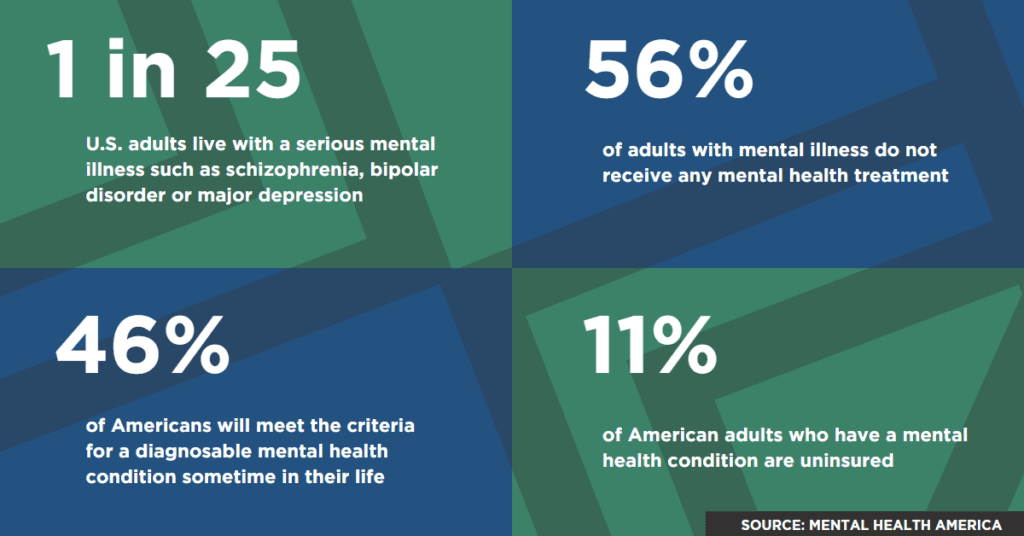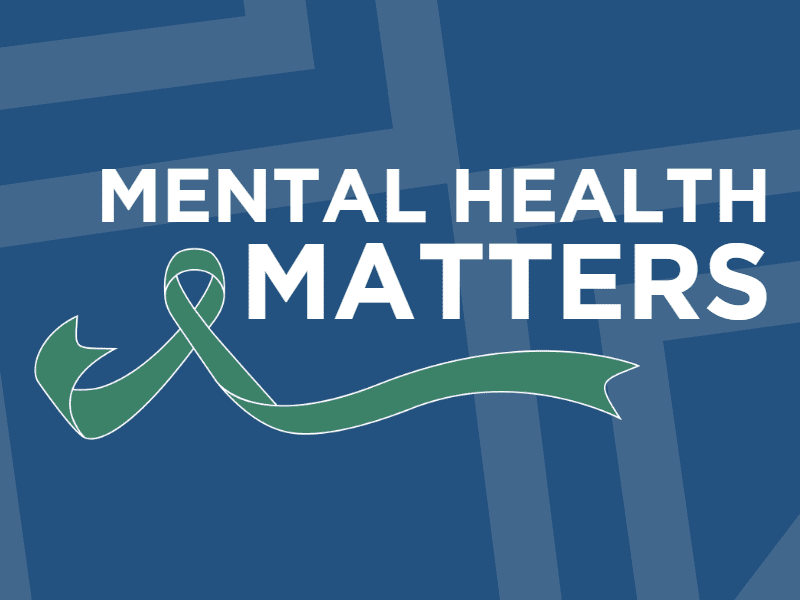Casi 20% de los estadounidenses padecen algún tipo de enfermedad mentalsegún Salud mental en Américapero el problema no se reconoce tan a menudo como debería.
Los expertos afirman que casi todos sufrimos el "resfriado común" de la enfermedad mental, pero a diferencia de las dolencias físicas, los problemas de salud mental a menudo no se tratan o se ignoran, en gran parte debido al estigma asociado a la enfermedad mental.
Ronald C. Kessler, Doctorcatedrático de Política Sanitaria de la Familia McNeil, experto mundialmente reconocido en el estudio de la salud mental en el mundo. Facultad de Medicina de Harvard dice: "Nadie se escandalizaría si supiéramos que el 99% de las personas ha tenido una enfermedad física a lo largo de su vida. Ya sea un resfriado o un cáncer; del mismo modo, todos hemos padecido alguna vez la forma de resfriado común de la enfermedad mental."
¿QUÉ ES LA SALUD MENTAL?
La salud mental es el término general que engloba el bienestar emocional, psicológico y social. Nuestra salud mental influye directamente en cómo pensamos, sentimos y actuamos, además de determinar cómo manejamos el estrés, nos relacionamos con los demás y tomamos decisiones.
>> MÁS INFORMACIÓN SOBRE LAS ENFERMEDADES MENTALES MÁS COMUNES
Según Salud mental en AméricaCasi la mitad de los estadounidenses cumplirán los criterios para que se les diagnostique un trastorno mental en algún momento de su vida, pero las enfermedades mentales son diferentes para cada persona. Al igual que las dolencias físicas, los problemas de salud mental pueden presentar una amplia gama de síntomas, duración y gravedad.


RECONOCIMIENTO Y ACCIÓN
La salud mental es importante, pero los problemas de salud mental pueden ser difíciles de reconocer y tratar. Los síntomas no sólo se manifiestan de forma diferente en cada persona, sino que a menudo son "invisibles" para todo el mundo excepto para el propio paciente.
Ser consciente de los síntomas comunes de las enfermedades mentales puede ayudar mucho a identificarlas antes de que se descontrolen, ya sea en uno mismo o en un ser querido. Entre los comportamientos a los que hay que prestar atención están los cambios de humor, la tristeza, la ansiedad, la irritabilidad, la falta de energía, los delirios, las alucinaciones o los problemas de sueño.
TRATAMIENTO DE LAS ENFERMEDADES MENTALES
Según Administración de Servicios de Salud Mental y Abuso de Sustancias (SAMHSA)La investigación demuestra que el tratamiento de las enfermedades mentales funciona y la mayoría de los planes de salud lo cubren.
A pesar de la mejora de la cobertura de los problemas de salud mental, casi la mitad de las personas que viven con problemas de salud mental citan el coste o la falta de seguro médico como una de las razones por las que no recibieron atención. Afortunadamente, existen opciones de bajo coste o gratuitas para las personas que se enfrentan a estos obstáculos, como por ejemplo Línea de ayuda masiva.
SALUD MENTAL EN EL LUGAR DE TRABAJO
La salud mental puede repercutir en nuestra vida cotidiana, tanto personal como profesionalmente.
Mala salud mental y altos niveles de estrés puede provocar absentismo, bajo rendimiento laboral y problemas de productividad. Puede afectar incluso a cosas básicas como la comunicación con los compañeros de trabajo y el funcionamiento diario.
Estos problemas no sólo afectan a la persona que padece una enfermedad mental, sino que también son costosos para los empresarios. Según la CDC (Centros para el Control y la Prevención de Enfermedades)Las empresas de todo el país pierden entre 1.000 y 44.000 millones de euros al año debido a los días de trabajo perdidos por problemas de salud mental. Las enfermedades mentales también se asocian a mayores tasas de desempleo y discapacidad.
Burnout es un fenómeno de estrés específico del lugar de trabajo. El estrés prolongado y mal gestionado en el trabajo puede llevar a alguien a experimentar agotamiento. Puede provocar falta de energía, agotamiento, falta de energía o entusiasmo por el trabajo. En general, una persona que experimenta burnout no es tan eficaz en su trabajo.


Debbie Sorenson, psicóloga clínica licenciada en Harvard, afirma una forma de evitar el agotamiento es ser consciente de uno mismo. Sorenson dice que cuando uno se siente estresado, es buena idea "hacer una pausa, darse cuenta, elegir". Haz una pausa, da un paseo o vete a estar solo. Después de tomarte un segundo para calmarte, pregúntate de dónde viene esa sensación y por qué te ocurre ahora. Por último, piensa qué es importante para ti en esa situación y actúa como mejor te parezca. Concédete una distracción positiva, como llamar a un ser querido o escuchar música relajante. Según ella, el ejercicio sólo dura 5 minutos, pero lo importante es el aspecto intencional.
¿QUÉ PUEDEN HACER LOS EMPRESARIOS?
Crear una cultura en el lugar de trabajo que no sólo reconozca la salud mental, sino que la apoye proactivamente, puede contribuir en gran medida a que los empleados se sientan respaldados y a reducir los problemas de salud mental que afectan al lugar de trabajo.
El CDC recomienda que los empresarios apoyen proactivamente la salud mental de sus empleados con medidas como:
- Acceso de los empleados a autoevaluaciones de salud mental
- Ofrecer pruebas de detección de la depresión realizadas por un profesional médico cualificado y ofrecer paquetes de prestaciones con cobertura de salud mental.
- Elaborar materiales como vídeos o folletos para concienciar sobre los problemas de salud mental más comunes y las posibilidades de tratamiento accesibles.
- Organizar seminarios y talleres sobre salud mental y gestión del estrés para todos los empleados, así como formación para directivos sobre cómo reconocer los signos y síntomas en sus empleados.
- Crear espacios dedicados en la oficina para que los empleados se relajen y tengan momentos de tranquilidad.
Organizaciones como Prudential Financial y Tripler Army Medical Center demuestran que los programas de concienciación sobre salud mental en el lugar de trabajo funcionan. Así que.., ¿qué pueden hacer otros empresarios?
También existe una amplia variedad de programas de certificación de centros de trabajo como Sello Bell de Mental Health America para la salud mental en el lugar de trabajo que ofrecen directrices a los empresarios comprometidos con la creación de lugares de trabajo mentalmente sanos.
¿QUÉ TRABAJOS SON LOS MÁS ESTRESANTES?
En pocas palabras, algunos trabajos son más estresantes que otros. Las largas jornadas laborales, los salarios bajos, los mayores riesgos para la seguridad personal y las grandes cargas de trabajo son razones habituales por las que los trabajadores declaran altos niveles de estrés en el trabajo.
>> PREVENCIÓN DEL SUICIDIO EN EL SECTOR DE LA CONSTRUCCIÓN
Según US World News and Report, los trabajadores de estructuras de hierro y acero son los que más difícil lo tienen, encabezando la lista de los Los 20 trabajos más estresantes. Los guardias de seguridad, los trabajadores de la construcción y los trabajadores sociales infantiles y familiares también se sitúan entre los primeros puestos.
En general, los trabajadores que declararon niveles de estrés más bajos tendían a tener un mejor equilibrio entre la vida laboral y personal, además de unos requisitos educativos menos rigurosos. Las funciones con ingresos superiores a la media también solían considerarse menos estresantes.
>> ENFERMEDADES CAUSADAS POR EL ESTRÉS LABORAL
INDEMNIZACIÓN DE LOS TRABAJADORES POR PROBLEMAS DE SALUD MENTAL
Los trabajadores con mala salud mental debido a su entorno laboral pueden reclamar indemnización por accidente de trabajo caso por caso, pero cada Estado tiene leyes diferentes que rigen lo que constituye una reclamación cualificada.
>> ¿TENGO DERECHO A UNA INDEMNIZACIÓN POR ESTRÉS LABORAL?
Para recibir una indemnización laboral por estrés o ansiedad en Massachusettsun empleado debe demostrar:
- Estrés o ansiedad sostenidos tras acontecimientos en el lugar de trabajo.
- Los acontecimientos en el lugar de trabajo fueron la causa principal del estrés o la ansiedad del trabajador.
- El estrés y la ansiedad del empleado superan el estrés y la ansiedad típicos esperados en el lugar de trabajo.
En Nuevo HampshireLas reclamaciones de indemnización por accidente de trabajo deben demostrar una manifestación física. Las lesiones mentales sólo son indemnizables si no son consecuencia de medidas disciplinarias, evaluación del trabajo, traslado de puesto, despido, descenso de categoría, despido o circunstancias similares. Para que un trabajador reciba una indemnización por estrés o ansiedad, tiene que demostrar que su enfermedad está acompañada de un elemento físico y que los factores estresantes relacionados con el trabajo no son los típicos que provocan estrés o ansiedad.
>> TRASTORNO POR ESTRÉS POSTRAUMÁTICO E INDEMNIZACIÓN LABORAL: ¿TENGO DERECHO A RECLAMAR?
Para recibir una indemnización laboral por estrés o ansiedad en Rhode IslandLos trabajadores tienen que demostrar que la lesión psíquica ha sido causada por un traumatismo físico o que coincide con un traumatismo físico, o que la enfermedad psíquica ha sido causada por un estrés emocional muy superior al habitual en el trabajo.





